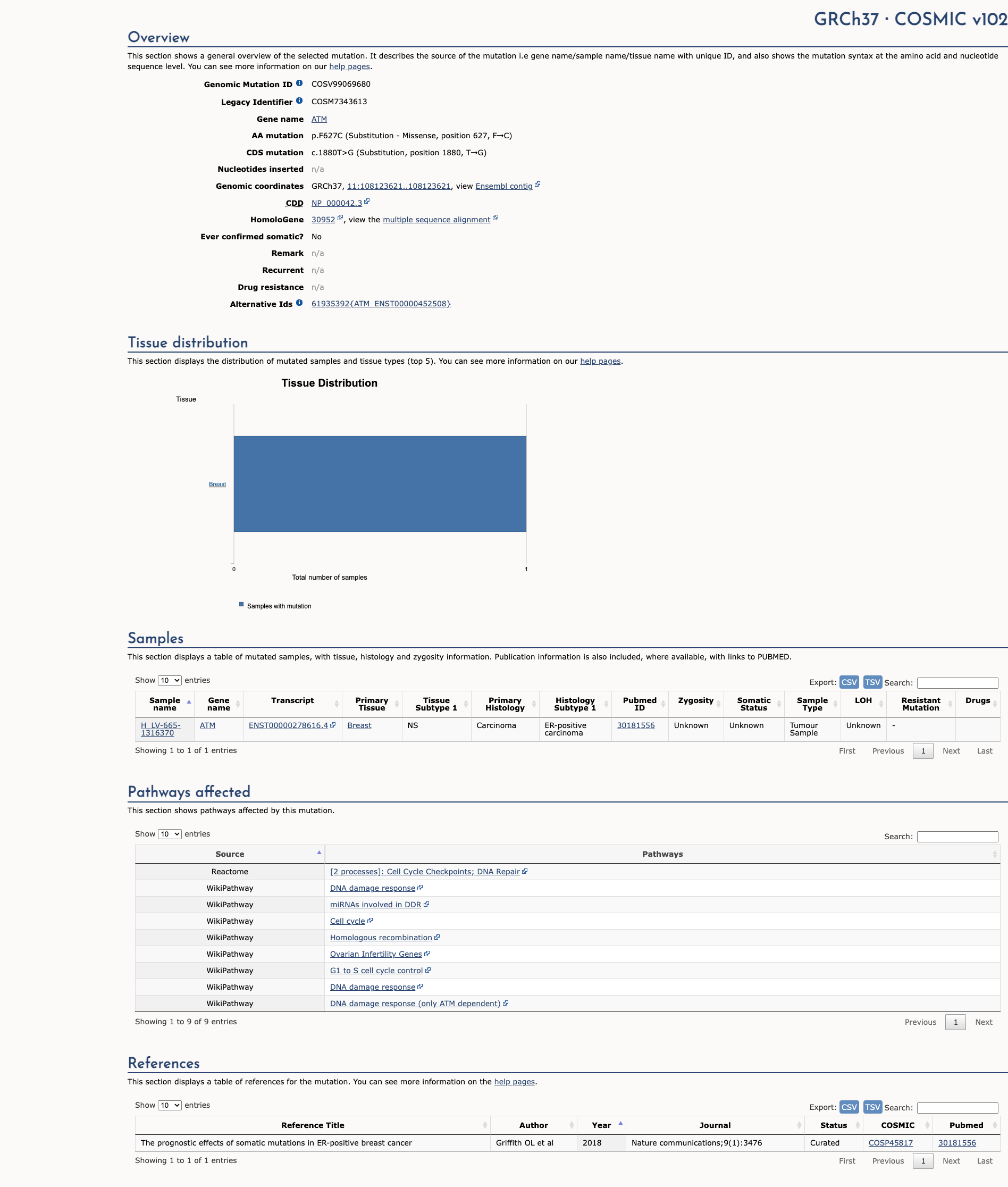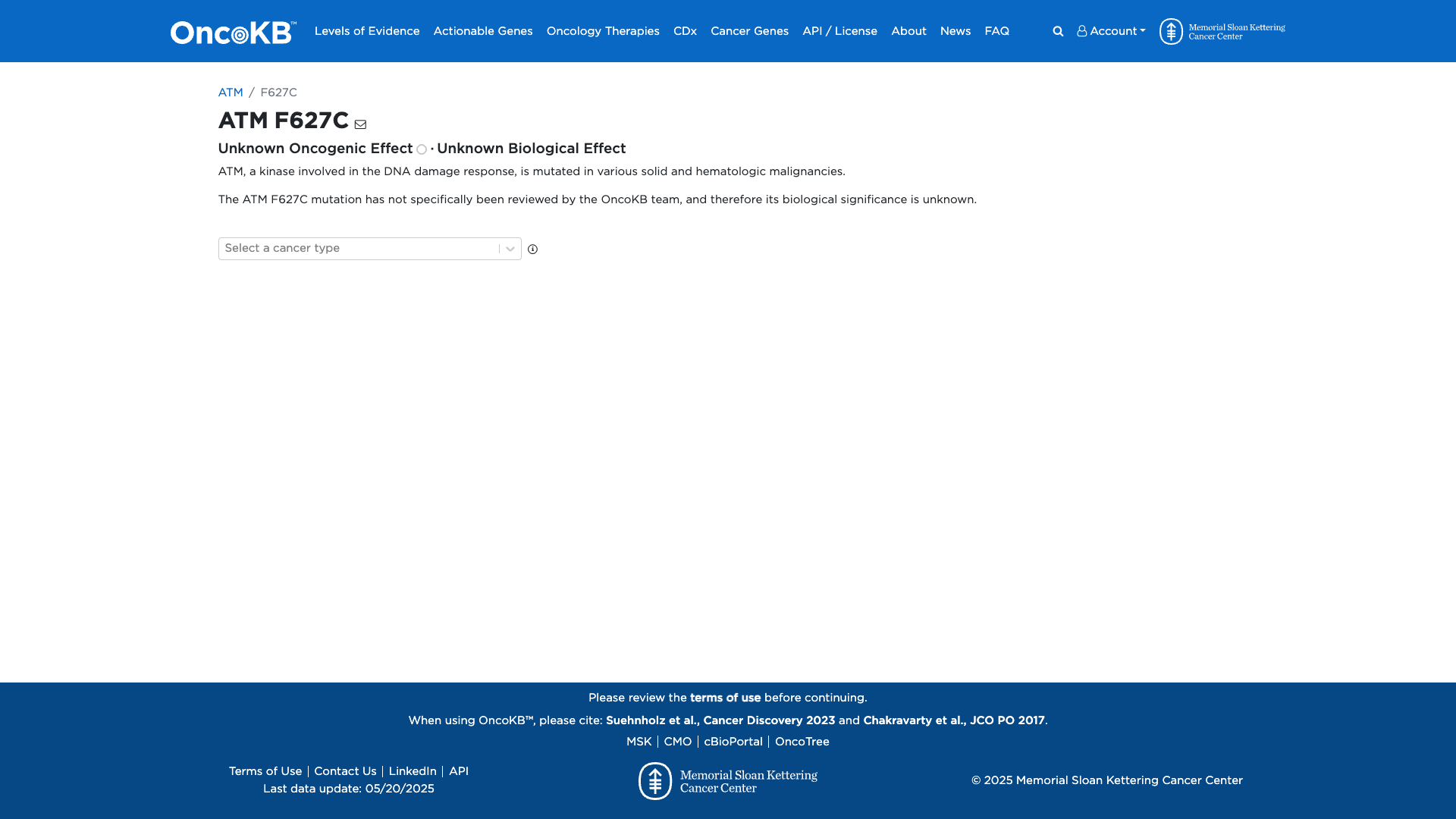ATM c.1880T>G, p.Phe627Cys
NM_000051.4:c.1880T>G
COSMIC ID: COSM7343613
Variant of Uncertain Significance (VUS)
Per ATM‐specific VCEP guidelines, no pathogenic or benign criteria are met for c.1880T>G (p.F627C); allele frequency is above PM2_supporting threshold and computational scores do not meet BP4 or PP3 thresholds. Classification remains Variant of Uncertain Significance.
ACMG/AMP Criteria Applied
No ACMG/AMP criteria definitively applied.
Genetic Information
Gene & Transcript Details
Gene
ATM
Transcript
NM_000051.4
MANE Select
Total Exons
63
Strand
Forward (+)
Reference Sequence
NC_000011.9
Alternative Transcripts
| ID | Status | Details |
|---|---|---|
| NM_000051.3 | RefSeq Select | 63 exons | Forward |
Variant Details
HGVS Notation
NM_000051.4:c.1880T>G
Protein Change
F627C
Location
Exon 12
(Exon 12 of 63)
5'Exon Structure (63 total)3'
Functional Consequence
Loss of Function
Related Variants
No evidence of other pathogenic variants at position 627 in gene ATM
Alternate Identifiers
COSM7343613
Variant interpretation based on transcript NM_000051.4
Genome Browser
Loading genome browser...
HGVS InputNM_000051:c.1880T>G
Active Tracks
ConservationRefSeqClinVargnomAD
Navigation tips: Use mouse to drag and zoom. Click on features for details.
Clinical Data
Global Frequency
0.00142%
Rare
Highest in Population
European (non-Finnish)
0.00311%
Rare
Global: 0.00142%
European (non-Finnish): 0.00311%
0%
0.05%
0.1%
1%
5%
10%+
Allele Information
Total: 282200Alt: 4Homozygotes: 0
ACMG Criteria Applied
PM2
This variant is present in gnomAD (MAF= 0.00142%, 4/282200 alleles, homozygotes = 0) and at a higher frequency in the European (non-Finnish) population (MAF= 0.00311%, 4/128786 alleles, homozygotes = 0). The variant is rare (MAF < 0.1%), supporting PM2 criterion application.
Classification
4 publications
Uncertain Significance (VUS)
Based on 10 submitter reviews in ClinVar
Submitter Breakdown
10 VUS
Pathogenic
Likely Path.
VUS
Likely Benign
Benign
Publications (4)
The p.F627C variant (also known as c.1880T>G), located in coding exon 11 of the ATM gene, results from a T to G substitution at nucleotide position 1880. The phenylalanine at codon 627 is replaced by cysteine, an amino acid with highly dissimilar properties. This alteration has been detected in 1/4112 breast cancer patients and 0/2399 healthy control individuals across numerous studies (Tavtigian S et al. Am J Hum Genet. 2009 Oct;85(4):427-46). This alteration has been reported in the germline of 2 of 8920 ethnically matched normal population control subjects but was not seen in 516 samples from a study of chronic lymphocytic leukemia patients of European descent (Tiao G et al. Leukemia, 2017 10;31:2244-2247). This variant was also identified in a patient with breast cancer (Bernstein JL et al. J Natl Cancer Inst, 2010 Apr;102:475-83). This amino acid position is well conserved in available vertebrate species. In addition, the in silico prediction for this alteration is inconclusive. Since supporting evidence is limited at this time, the clinical significance of this alteration remains unclear.
This sequence change replaces phenylalanine, which is neutral and non-polar, with cysteine, which is neutral and slightly polar, at codon 627 of the ATM protein (p.Phe627Cys). This variant is present in population databases (rs546087885, gnomAD 0.003%). This missense change has been observed in individual(s) with breast cancer (PMID: 11996792, 12935922, 19781682). ClinVar contains an entry for this variant (Variation ID: 232928). Invitae Evidence Modeling of protein sequence and biophysical properties (such as structural, functional, and spatial information, amino acid conservation, physicochemical variation, residue mobility, and thermodynamic stability) indicates that this missense variant is not expected to disrupt ATM protein function with a negative predictive value of 95%. In summary, the available evidence is currently insufficient to determine the role of this variant in disease. Therefore, it has been classified as a Variant of Uncertain Significance.
This missense variant replaces phenylalanine with cysteine at codon 627 of the ATM protein. Computational prediction suggests that this variant may not impact protein structure and function. To our knowledge, functional studies have not been reported for this variant. This variant has been reported in individuals affected with breast cancer (PMID: 11996792, 12935922, 19781682). In a large international case-control study, this variant was reported in 7/60466 breast cancer cases and 1/53461 controls (OR=6.19, 95%CI 0.761 to 50.312, p-value=0.074; PMID: 33471991). This variant has been identified in 4/282200 chromosomes in the general population by the Genome Aggregation Database (gnomAD). The available evidence is insufficient to determine the role of this variant in disease conclusively. Therefore, this variant is classified as a Variant of Uncertain Significance.
Variant summary: ATM c.1880T>G (p.Phe627Cys) results in a non-conservative amino acid change in the encoded protein sequence. Three of five in-silico tools predict a damaging effect of the variant on protein function. The variant allele was found at a frequency of 1.2e-05 in 250808 control chromosomes (gnomAD). The available data on variant occurrences in the general population are insufficient to allow any conclusion about variant significance. c.1880T>G has been reported in the literature in individuals affected with Breast Cancer (Bernstein_2010, Sommer_2003, Tavtigian_2009). These reports do not provide unequivocal conclusions about association of the variant with Breast Cancer. To our knowledge, no experimental evidence demonstrating an impact on protein function has been reported. Six ClinVar submissions (evaluation after 2014) cite the variant as uncertain significance. Based on the evidence outlined above, the variant was classified as uncertain significance.
Clinical Statement
This variant has been reported in ClinVar as Uncertain significance (10 clinical laboratories) and as Uncertain Significance (1 clinical laboratories).
Functional Impact
Functional Domain
Hotspot Status
Not a hotspot
Domain Summary
This variant is not located in a mutational hotspot or critical domain (0 mutations).
Related Variants in This Domain
No evidence of other pathogenic variants at position 627 in gene ATM
Computational Analysis
Pathogenicity Predictions
REVEL Score
0.338
0.338
Likely Benign0.0
Uncertain (Low)0.2
Uncertain (Med)0.5
Likely Pathogenic0.75
REVEL scores ≥ 0.75 are strong evidence (PP3)
Predictor Consensus
Mixed/VUS
PP3 Applied
No
Additional Predictors
Benign:
CADD: 4.67metasvm: Tmetalr: Tprimateai: T
Neutral: Show all
VCEP Guidelines
Applied ACMG/AMP Criteria (VCEP Specific) VCEP Guidelines
PVS1
PVS1 (Not Applied) Strength Modified
According to VCEP guidelines: PVS1 applies to predicted null variants per the ATM PVS1 Decision Tree. This variant is a missense change (F627C) and not predicted to cause loss of function. Therefore, PVS1 is not applied.
PS1
PS1 (Not Applied) Strength Modified
According to VCEP guidelines: PS1 applies when the same amino acid change as a previously established pathogenic variant is observed. No known pathogenic variant results in F627C. Therefore, PS1 is not applied.
PS2
PS2 (Not Applied) Strength Modified
According to standard ACMG guidelines: PS2 applies for confirmed de novo occurrences. No de novo data are available for this variant. Therefore, PS2 is not applied.
PS3
PS3 (Not Applied) Strength Modified
According to VCEP guidelines: PS3 (any strength) requires functional assays demonstrating impact on ATM‐specific features. No functional characterization exists for F627C. Therefore, PS3 is not applied.
PS4
PS4 (Not Applied) Strength Modified
According to VCEP guidelines: PS4 applies for significant case–control data. No case–control or cohort data are available. Therefore, PS4 is not applied.
PM1
PM1 (Not Applied) Strength Modified
According to standard ACMG guidelines: PM1 applies to variants in well‐established functional domains or hotspots. F627C is not located in a defined ATM hotspot or critical functional domain. Therefore, PM1 is not applied.
PM2
PM2 (Not Applied) Strength Modified
According to VCEP guidelines: PM2_supporting applies for allele frequency ≤0.001% (n=1). This variant has MAF=0.00142% with n=4 in gnomAD. Therefore, PM2 is not applied.
PM3
PM3 (Not Applied) Strength Modified
According to VCEP guidelines: PM3 applies for observed trans occurrence in recessive cases. No such data exist for this variant. Therefore, PM3 is not applied.
PM4
PM4 (Not Applied) Strength Modified
According to standard ACMG guidelines: PM4 applies to protein length changes (in‐frame indels, stop‐loss). F627C is a missense change. Therefore, PM4 is not applied.
PM5
PM5 (Not Applied) Strength Modified
According to VCEP guidelines: PM5_supporting applies to truncating variants upstream of p.Arg3047. F627C is not truncating. Therefore, PM5 is not applied.
PM6
PM6 (Not Applied) Strength Modified
According to standard ACMG guidelines: PM6 applies for assumed de novo without confirmation. No de novo suspicion exists. Therefore, PM6 is not applied.
PP1
PP1 (Not Applied) Strength Modified
According to standard ACMG guidelines: PP1 applies for segregation in multiple affected family members. No segregation data are available. Therefore, PP1 is not applied.
PP2
PP2 (Not Applied) Strength Modified
According to standard ACMG guidelines: PP2 applies to genes with low rate of benign missense and where missense is common disease mechanism. ATM tolerates missense variation. Therefore, PP2 is not applied.
PP3
PP3 (Not Applied) Strength Modified
According to VCEP guidelines: PP3_supporting applies for REVEL >0.7333 or splicing impact. REVEL=0.34 (<0.7333) and SpliceAI predicts no splice impact. Therefore, PP3 is not applied.
PP4
PP4 (Not Applied) Strength Modified
According to standard ACMG guidelines: PP4 applies for highly specific phenotype. No clinical phenotype data provided. Therefore, PP4 is not applied.
PP5
PP5 (Not Applied) Strength Modified
According to standard ACMG guidelines: PP5 applies for reputable source classification as pathogenic. ClinVar lists this variant as VUS. Therefore, PP5 is not applied.
BA1
BA1 (Not Applied) Strength Modified
According to VCEP guidelines: BA1 applies for allele frequency >0.5%. MAF=0.00142% is well below threshold. Therefore, BA1 is not applied.
BS1
BS1 (Not Applied) Strength Modified
According to VCEP guidelines: BS1 applies for allele frequency >5%. MAF=0.00142% is below threshold. Therefore, BS1 is not applied.
BS2
BS2 (Not Applied) Strength Modified
According to standard ACMG guidelines: BS2 applies when variant is observed in healthy adults with full penetrance expected. No such data exist. Therefore, BS2 is not applied.
BS3
BS3 (Not Applied) Strength Modified
According to VCEP guidelines: BS3 applies when functional assays show rescue of ATM function. No rescue data exist. Therefore, BS3 is not applied.
BS4
BS4 (Not Applied) Strength Modified
According to standard ACMG guidelines: BS4 applies for lack of segregation in families. No segregation data available. Therefore, BS4 is not applied.
BP1
BP1 (Not Applied) Strength Modified
According to standard ACMG guidelines: BP1 applies to missense variants in genes where only loss‐of‐function causes disease. ATM disease mechanism includes missense in some contexts. Therefore, BP1 is not applied.
BP2
BP2 (Not Applied) Strength Modified
According to standard ACMG guidelines: BP2 applies for observed in trans with pathogenic variant in dominant disorder or cis in recessive. No such data exist. Therefore, BP2 is not applied.
BP3
BP3 (Not Applied) Strength Modified
According to standard ACMG guidelines: BP3 applies to in‐frame indels in repetitive regions. F627C is a missense change. Therefore, BP3 is not applied.
BP4
BP4 (Not Applied) Strength Modified
According to VCEP guidelines: BP4_supporting applies for REVEL ≤0.249. REVEL=0.34 (>0.249). Although SpliceAI predicts no impact on splicing, the guideline protein threshold is not met. Therefore, BP4 is not applied.
BP5
BP5 (Not Applied) Strength Modified
According to standard ACMG guidelines: BP5 applies when variant is found in trans with pathogenic variant in a recessive disorder. No such observations. Therefore, BP5 is not applied.
BP6
BP6 (Not Applied) Strength Modified
According to standard ACMG guidelines: BP6 applies for a variant asserted benign by a reputable source without evidence. No such assertion exists. Therefore, BP6 is not applied.
BP7
BP7 (Not Applied) Strength Modified
According to standard ACMG guidelines: BP7 applies to synonymous or deep intronic variants with no splice impact. F627C is a missense variant. Therefore, BP7 is not applied.



